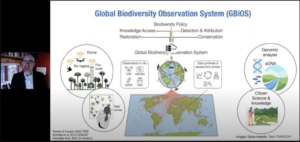The GEO BON Secretariat and several of its network members were busy since November 2021 and over the holidays working on a large synthesis of scientific knowledge as input for the Post-2020 Global Biodiversity Framework (GBF) of the UN Convention on Biological Diversity (CBD). GEO BON worked in partnership with bioDISCOVERY (a Future Earth programme) to convene a group of 52 experts which produced an information document (CBD/SBSTTA/24/INF/31), serving as an update to participants in the 3rd meeting of the Open-ended Working Group (OEWG-3) on the GBF and the 24th meeting of the Subsidiary Body on Scientific, Technical and Technological Advice (SBSTTA-24) on how the 21 Action Targets of the GBF can contribute to achieving the biodiversity milestones and goals, particularly Goal A, of the framework.
This initiative emerged from the consensus observed during virtual SBSTTA-24 and OEWG-3 meetings in 2021 for a need to better reveal the linkages between actions on drivers of biodiversity loss (i.e., land and sea use change, climate change, natural resource use and exploitation, pollution, and invasive alien species) and their outcomes on dimensions of biodiversity (genes, traits, species, populations, communities, and ecosystems).

development of the information document.
The 182-page synthesis was featured in various international news sources, including The Guardian, Le Monde, The Globe and Mail, Heute and Nature.
The main findings and key messages of the document were presented during the CBD’s on-going series of Webinars to Support the Discussions at the Resumed Sessions of SBSTTA-24, SBI-3 and WG2020-3.
Recordings of the morning and evening sessions of this webinar can be found here and here, respectively.
CBD/SBSTTA/24/INF/31: “Transformative actions on all drivers of biodiversity loss are urgently required to achieve the global goals by 2050” — Key messages:
1. High levels of ambition for halting and reversing biodiversity loss (Goal A) cannot be met without transformative change which is a “fundamental, system-wide reorganization across technological, economic and social factors, including paradigms, goals and values, needed for the conservation and sustainable use of biodiversity, long-term human wellbeing and sustainable development”.
2. Achieving ambitious objectives for ecosystems, species and genetic diversity (Goal A) depends on a comprehensive portfolio of actions to reduce all of the direct drivers of biodiversity from land and sea use change, direct exploitation of organisms, climate change, pollution, invasive alien species, and their interactions.
3. Global targets of the GBF provide an important template for action, but it is how these targets are implemented and how actions are coordinated across local, national and international levels that will determine success in achieving objectives for biodiversity. Regular assessments of the implementation of targets and their contributions to progress towards clearly defined goals and milestones for biodiversity are therefore vital elements of the GBF.
4. Reversing biodiversity loss will require addressing threats to biodiversity in both natural and managed ecosystems, as well as the interconnections between them. “Natural” and “managed” ecosystems differ in their species and genetic composition, ecosystem functions and supply of benefits to people, hence the targets for action, reference states, monitoring requirements, and relevant indicators differ between them.
5. All dimensions of biodiversity — genetic, population, species, community and ecosystem — show interlinked responses to human drivers. Efforts to mitigate the effects on drivers on one dimension (e.g population abundances) will depend on action on other dimensions (e.g. genetic diversity). Knowledge of the interlinked relationships between dimensions can be used to guide prioritization for conservation.
6. Ambitious action is needed as soon as possible and must be sustained over time if we are to put biodiversity on a trend to recovery by mid-century. There is good evidence that while some dimensions of biodiversity recover rapidly following conservation action, many show long-lasting, or time-delayed, changes in response to actions to mitigate the effects of drivers.
7. The degree of biodiversity change, and relative importance of drivers, vary greatly across scales and from place to place, and drivers in one place can affect biodiversity far away in other places.
8. Successful implementation of the GBF requires substantial investment in monitoring capacity to detect change and attribute drivers. Ensure the supply of, and access to, data that underpin the effective use of indicators to track progress and guide action needed to implement the GBF at local, national and international levels. The set of indicators for monitoring progress to Goal A of the GBF should be expanded to comprehensively cover outcomes, drivers, and actions and the interdependencies between them.
A new horizon for biodiversity monitoring
Monitoring is an essential part of achieving the milestones and goals of the GBF. It not only informs us on the state of biodiversity but improves our capacity to prioritize conservation actions and attribute changes in biodiversity state to changes in our everyday actions.
During the CBD’s webinar series on the Updated Monitoring Framework, Andy Gonzalez gave an impassioned description of the Global Biodiversity Observation System (GBiOS)—a network of networks the international community will need to track and inform our progress towards the 2050 global biodiversity goals.

information documents (SBSTTA item 3) webinar.
Watch this webinar recording here.
